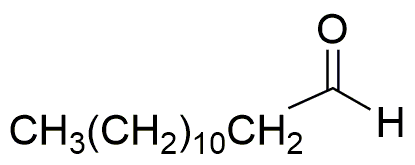Tridecanal is widely utilized in research focused on:
- Flavor and Fragrance Industry: Used as a flavoring agent in food products and a fragrance component in cosmetics, providing a pleasant scent and taste.
- Biochemical Research: Serves as a model compound in studies related to fatty aldehydes, helping researchers understand lipid metabolism and related diseases.
- Surfactant Production: Acts as a precursor in the synthesis of surfactants, which are essential in detergents and emulsifiers, enhancing cleaning efficiency.
- Pharmaceutical Applications: Explored for its potential in drug formulation, particularly in developing lipid-based drug delivery systems for improved bioavailability.
- Industrial Lubricants: Used in the formulation of lubricants, providing enhanced stability and performance in various mechanical applications.
General Information
Properties
Safety and Regulations
Applications
Tridecanal is widely utilized in research focused on:
- Flavor and Fragrance Industry: Used as a flavoring agent in food products and a fragrance component in cosmetics, providing a pleasant scent and taste.
- Biochemical Research: Serves as a model compound in studies related to fatty aldehydes, helping researchers understand lipid metabolism and related diseases.
- Surfactant Production: Acts as a precursor in the synthesis of surfactants, which are essential in detergents and emulsifiers, enhancing cleaning efficiency.
- Pharmaceutical Applications: Explored for its potential in drug formulation, particularly in developing lipid-based drug delivery systems for improved bioavailability.
- Industrial Lubricants: Used in the formulation of lubricants, providing enhanced stability and performance in various mechanical applications.
Documents
Safety Data Sheets (SDS)
The SDS provides comprehensive safety information on handling, storage, and disposal of the product.
Product Specification (PS)
The PS provides a comprehensive breakdown of the product’s properties, including chemical composition, physical state, purity, and storage requirements. It also details acceptable quality ranges and the product's intended applications.
Certificates of Analysis (COA)
Search for Certificates of Analysis (COA) by entering the products Lot Number. Lot and Batch Numbers can be found on a product’s label following the words ‘Lot’ or ‘Batch’.
*Catalog Number
*Lot Number
Certificates Of Origin (COO)
This COO confirms the country where the product was manufactured, and also details the materials and components used in it and whether it is derived from natural, synthetic, or other specific sources. This certificate may be required for customs, trade, and regulatory compliance.
*Catalog Number
*Lot Number
Safety Data Sheets (SDS)
The SDS provides comprehensive safety information on handling, storage, and disposal of the product.
DownloadProduct Specification (PS)
The PS provides a comprehensive breakdown of the product’s properties, including chemical composition, physical state, purity, and storage requirements. It also details acceptable quality ranges and the product's intended applications.
DownloadCertificates of Analysis (COA)
Search for Certificates of Analysis (COA) by entering the products Lot Number. Lot and Batch Numbers can be found on a product’s label following the words ‘Lot’ or ‘Batch’.
*Catalog Number
*Lot Number
Certificates Of Origin (COO)
This COO confirms the country where the product was manufactured, and also details the materials and components used in it and whether it is derived from natural, synthetic, or other specific sources. This certificate may be required for customs, trade, and regulatory compliance.

